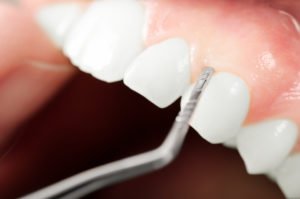
February is known for the color red because of Valentine’s Day—a time for cupids, hearts, roses, and everything else that is the color of love. However, this month is also a time for awareness of a different type of red: gum disease. This issue currently affects about half of the American population, which is why February is now officially Gum Disease Awareness Month. Keep reading to learn more about this problem and when you may need gum disease treatment in Springfield.
What is Gum Disease?
Gum disease is an infection and inflammation of the gums that affects millions of people. Typically caused by poor dental hygiene, this issue can be completely reversed in its early stages. However, if left untreated, gum disease can cause permanent tissue damage, bone deterioration, and even tooth loss. Unfortunately, the problems don’t stop there. More recent studies have shown a direct relationship between gum disease and increased risks of heart attacks, strokes, Alzheimer’s disease, and other overall health difficulties.
How Do You Know if You have It?
Because gum disease can be reversed if it’s caught early on, you should be on the lookout for these common warning signs:
- Puffy or sensitive gums
- Red or discolored gums
- Gums that bleed when you brush or floss
- Teeth that appear longer
- Persistent bad breath
- Changes in bite
Gum Disease Treatment
Once your gum disease has persisted past the beginning stages, you may need treatment. The most common solution is called scaling and root planing. This is done by first thoroughly cleaning the smiel, removing plaque and tartar buildup from above, on, and beneath your gums. Then, your dentist in Springfield will reach under the gums to smooth out your tooth roots, making it harder for debris and bacteria to collect under your tissue. This treatment is often combined with antibiotics for many cases. However, if you’re gum disease is more advanced, you may need surgery to stop the infection from spreading.
How to Prevent Gum Disease
Thankfully, gum disease can be completely prevented if you follow a few key steps. Be sure to brush your teeth twice a day and floss once to remove daily plaque and bacteria. You can also add a nonalcoholic mouthwash to your routine for an extra layer of cleaning. Lastly, it’s important to see your dentist regularly for routine checkups and cleanings. They will examine the health of your gums, and they can detect infection before it becomes more extensive and expensive to treat.
Gum disease can be a serious problem, but not if you know how to prevent it as well as some of its main warning signs. Remember this useful information during this month of awareness and beyond!
Meet the Dentist
Dr. Gary C. Nawrocki has been committed to providing his patients with exceptional care ever since graduating with his Doctorate of Dentistry from the University of Florida in 1980. He offers a variety of options for gum disease treatment and he is a pro at catching signs of disease early. For any questions, he can be reached through his website or by phone at (321) 783-7514.
